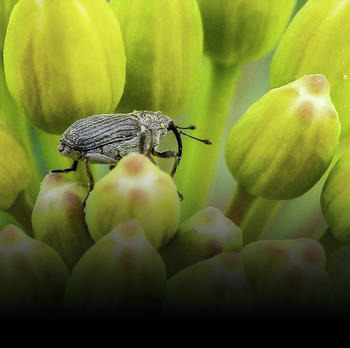Cabbage Seedpod Weevil (Ceutoryhnchus obstrictus)
- Beetle 2.5-3 mm, grey-black. Eats a hole in the pod to lay its eggs, this hole is also used by the cabbage pod mosquito to lay its eggs. Larvae individually in pods. 4-5 mm, legless, whitish yellow with brown head. At maturity, the larvae often have holes visible. 1 generation/ year. The beetle does not cause any damage, but is important as a precursor for the cabbage pod mosquito. Larvae eat only a few ovules, but infested pods often become fungus.
CONTROL BENCHMARK
- Yellow trap records only the start of inflow. Infestation is determined by counting. Best in the afternoon when the sun is warm and the beetles are active.
- Knock test on 5 bud stands in different areas of the plant. Beetles drop when disturbed and play dead.
- Control target reached when 12 - 25 beetles are detected on 5 x 5 = 25 plants. Corresponds to 1 beetle/plant at low mosquito risk or 0.5 beetles/plant at known high mosquito risk.
PREVENTION
- Preserve beneficial organism potential. Ichneumon flies parasitise the larvae, ground beetles and rove beetles can decimate the larvae migrating into the soil to pupate.
- If there are still young beetles in the field at harvest, the timely mulching of the rape stubble can decimate them




